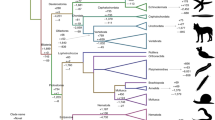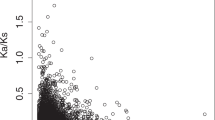Abstract
Biological diversity is driven mainly by gene duplication followed by mutation and selection. This divergence in either regulatory or protein-coding sequences can result in quite different biological functions for even closely related genes. This concept is exemplified by the mammalian Hox gene complex, a group of 39 genes which are located on 4 linkage groups, dispersed on 4 chromosomes1,2,3,4. The evolution of this complex began with amplification in cis of a primordial Hox gene to produce 13 members, followed by duplications in trans of much of the entire unit. As a consequence, Hox genes that occupy the same relative position along the 5′ to 3′ chromosomal coordinate (trans-paralogous genes) share more similarity in sequence and expression pattern than do adjacent Hox genes on the same chromosome. Studies in mice indicate that although individual family members may have unique biological roles, they also share overlapping functions with their paralogues5,6,7,8,9,10,11,12. Here we show that the proteins encoded by the paralogous genes, Hoxa3 and Hoxd3, can carry out identical biological functions, and that the different roles attributed to these genes are the result of quantitative modulations in gene expression.
This is a preview of subscription content, access via your institution
Access options
Subscribe to this journal
Receive 51 print issues and online access
$199.00 per year
only $3.90 per issue
Buy this article
- Purchase on SpringerLink
- Instant access to full article PDF
Prices may be subject to local taxes which are calculated during checkout



Similar content being viewed by others
References
Scott, M. P. Vertebrate homeobox gene nomenclature. Cell 71, 551–553 (1992).
Kappen, C., Schughart, K. & Ruddle, F. H. Two steps in the evolution of Antennapedia-class vertebrate homeobox genes. Proc. Natl Acad. Sci. USA 86, 5459–5463 (1989).
Duboule, D. & Dollé, P. The structural and functional organization of the murine Hox gene family resembles that of Drosophila homeotic genes. EMBO J. 8, 1497– 1505 (1989).
Holland, P. W. H. & Garcia–Fernandez, J. Hox genes and chordate evolution. Dev. Biol. 173 , 382–395 (1996).
Condie, B. G. & Capecchi, M. R. Mice with targeted disruptions in the paralogous genes hoxa-3 and hoxd-3 reveal synergistic interactions. Nature 370, 304– 307 (1994).
Davis, A. P., Witte, D. P., Hsieh–Li, H. M., Potter, S. S. & Capecchi, M. R. Absence of radius and ulna in mice lacking hoxa-11 and hoxd-11. Nature 375, 791–795 (1995).
Horan, G. S. B. et al. Compound mutants for the paralogous hoxa-4, hoxb-4, and hoxd-4 genes show more complete homeotic transformations and a dose-dependent increase in the number of vertebrae transformed. Genes Dev. 9, 1667–1677 (1995).
Zákány, J., Gérard, M., Favier, B., Potter, S. S. & Duboule, D. Functional equivalence and rescue among group 11 Hox gene products in vertebral patterning. Dev. Biol 176, 325–328 ( 1996).
Gavalas, A. M. et al. Hoxa1 and Hoxb1 synergize in patterning the hindbrain, cranial nerves and second pharyngeal arch. Development 125, 1123–1136 ( 1998).
Studer, M. et al. Genetic interactions between Hoxa1 and Hoxb1 reveal new roles in regulation of early hindbrain patterning. Development 125, 1025–1036 (1998).
Fromental–Ramain, C. et al. Hoxa-13 and Hoxd-13 play a crucial role in the patterning of the limb autopod. Development 122, 2997 –3011 (1996).
Rossel, M. & Capecchi, M. R. Mice mutant for both Hoxa1 and Hoxb1 show extensive remodeling of the hindbrain and defects in craniofacial development. Development 126 (in the press).
Lonai, P., Arman, E., Czosnek, H., Ruddle, F. H. & Blatt, C. New murine homeoboxes: structure, chromosomal assignment and differential expression in adult erythropoiesis. DNA 6, 409–418 (1987).
Hunt, P. et al. A distinct Hox code for the branchial region of the vertebrate head. Nature 353, 861–864 (1991).
Hunt, P. et al. The branchial Hox code and its implications for gene regulation, patterning of the nervous system and head evolution. Dev. Suppl. 2, 63–77 (1991 ).
Sham, M. H. et al. Analysis of the murine Hox-2.7 gene: conserved alternative transcripts with differential distributions in the nervous system and the potential for shared regulatory regions. EMBO J. 11 , 1825–1836 (1992).
Manley, N. R. & Capecchi, M. R. Hox group 3 paralogous genes act synergistically in the formation of somitic and neural crest–derived structures. Dev. Biol. 192, 274– 288 (1997).
Chisaka, O. & Capecchi, M. R. Regionally restricted developmental defects resulting from targeted disruption of the mouse homeobox gene hox-1.5. Nature 350, 473– 479 (1991).
Condie, B. G. & Capecchi, M. R. Mice homozygous for a targeted disruption of Hoxd-3 (Hox-4.1) exhibit anterior transformations of the first and second cervical vertebrae, the atlas and the axis. Development 119, 579–595 (1993).
Manley, N. R. & Capecchi, M. R. The role of hoxa-3 in mouse thymus and thyroid development. Development 121 , 1989–2003 (1995).
Manley, N. R. & Capecchi, M. R. Hox group 3 paralogs regulate the development and migration of the thymus, thyroid and parathyroid glands. Dev. Biol. 195, 1– 15 (1998).
Capecchi, M. R. Hox genes and mammalian development. Cold Spring Harb. Symp. Quant. Biol. 62, 273–281 (1997).
Fitzgerald, K., Wilkinson, H. A. & Greenwald, I. Glp-1 can substitute for lin-12 in specifying cell fate decisions in Caenorhabditis elegans. Development 119, 1019–1027 ( 1993).
Hanks, M., Wurst, M., Anson–Cartwright, L., Auerbach, A. B. & Joyner, A. L. Rescue of the En–1 mutant phenotype by replacement of En-1 with En-2. Science 269, 679–682 ( 1995).
Thomas, K. R. & Capecchi, M. R. Site-directed mutagenesis by gene targeting in mouse embryo-derived stem cells. Cell 51, 503–512 (1987).
Bunting, M., Bernstein, K. E., Greer, J. M., Capecchi, M. R. & Thomas, K. R. Targeting genes for self-excision in the germline. Genes Dev. 13, 1524–1528 (1999).
Nagy, A., Rossant, J., Nagy, R., Abramow-Newerly, W. & Roder, J. C. Derivation of completely cell culture-derived mice from early-passage embryonic stem cells. Proc. Natl Acad. Sci. USA 90, 8424–8428 ( 1993).
Mansour, S. L., Thomas, K. R. & Capecchi, M. R. Disruption of the proto-oncogene int-2 in mouse embryo-derived stem cells: a general strategy for targeting mutations to non-selectable genes. Nature 336, 348 –352 (1988).
Schwenk, F., Baron, U. & Rajewsky, K. A cre-transgenic mouse strain for the ubiquitous deletion of loxP-flanked gene segments including deletion in germ cells. Nucleic Acids Res. 23, 5080– 5081 (1995).
Thomas, K. R., Musci, T. S., Neumann, P. E. & Capecchi, M. R. Swaying is a mutant allele of the proto-oncogene Wnt-1. Cell 67, 969–976 ( 1991).
Acknowledgements
We thank all members of the Capecchi laboratory's tissue culture support group and animal care facility for their expertise. Assistance from L. Oswald, P. Reid and D. Lim for manuscript preparation, and R. Beglarian for histology is appreciated. J.M.G. was supported by the Dee Fellowship and a NIH Genetics Training Grant.
Author information
Authors and Affiliations
Corresponding author
Rights and permissions
About this article
Cite this article
Greer, J., Puetz, J., Thomas, K. et al. Maintenance of functional equivalence during paralogous Hox gene evolution . Nature 403, 661–665 (2000). https://doi.org/10.1038/35001077
Received:
Accepted:
Issue Date:
DOI: https://doi.org/10.1038/35001077



